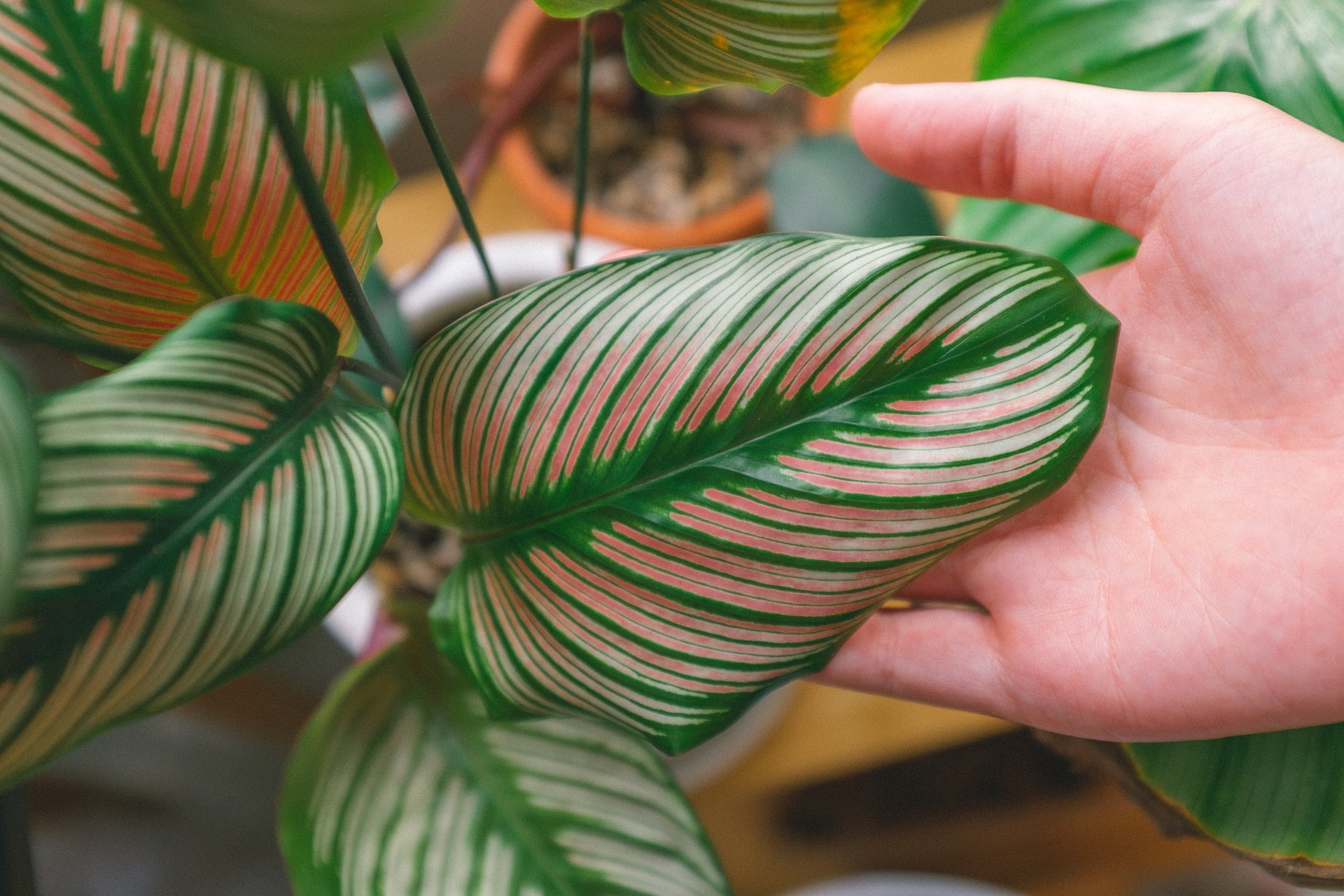Calatheas, known for their stunning foliage and unique patterns, has become a favorite among plant enthusiasts.
Explore the captivating world of Calatheas as we delve into the most searched types, a brief history, and essential care tips.
What Is a Calathea Plant?
A Calathea plant belongs to a diverse genus known for its striking foliage and vibrant patterns. These plants, often grown indoors, thrive in environments with indirect light and consistent moisture.
Their unique leaves and variety of species make them popular choices for adding a touch of natural beauty to indoor spaces.
Short History of Calatheas
Calatheas, hailed from the lush landscapes of South America, boasts a fascinating history intertwined with both cultural and botanical significance.
These tropical plants, belonging to the Marantaceae family, have been cherished for centuries, their journey marked by a blend of traditional rituals and modern-day admiration.
Origins and Indigenous Significance
Originating in the dense rainforests of Brazil, prayer plants played a pivotal role in indigenous cultures. Native communities utilized the large, vibrant leaves for practical purposes, weaving them into baskets, mats, and even as natural plates.
The robust foliage became symbolic in various ceremonies, representing the lush vitality of the rainforest.
Transition to Ornamental Plants
As global exploration and trade expanded, Calatheas found their way to new corners of the world.
Their intricate patterns and vivid colors caught the eye of botanists and collectors, leading to their cultivation as ornamental houseplants.
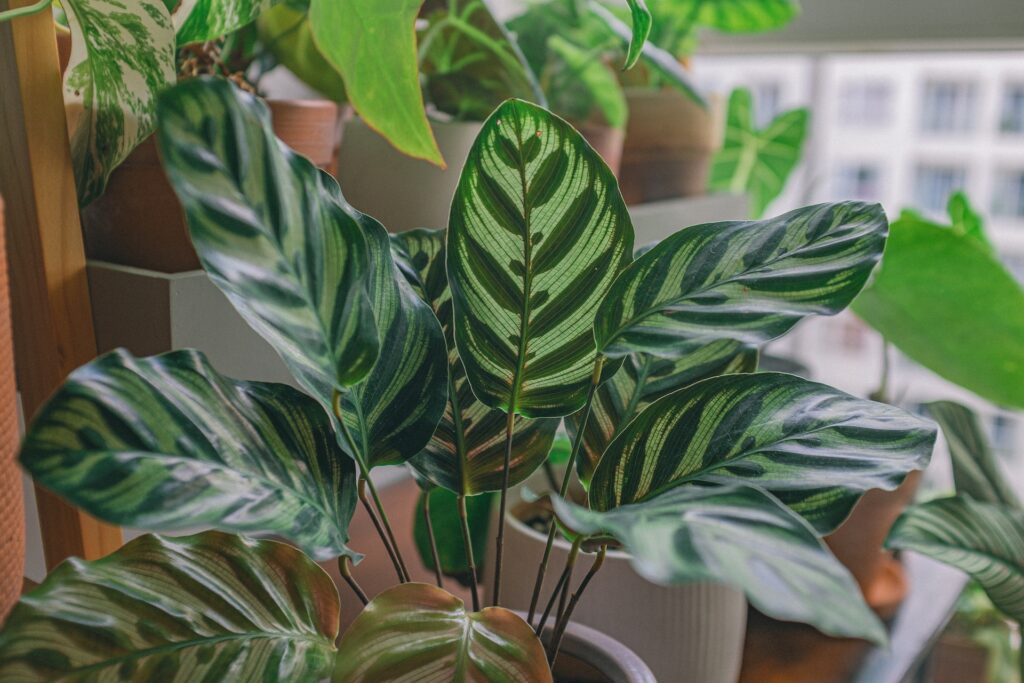
In the 19th century, Calatheas began gracing Victorian parlors, adding an exotic touch to the era’s fascination with plant collecting.
Symbolism and Spiritual Connection
In addition to their visual allure, these plants have maintained spiritual significance. In some cultures, these plants are believed to possess protective qualities, safeguarding homes from negative energy.
The rhythmic opening and closing of their leaves during the day and night have led to associations with prayer and meditation, further enhancing their mystique.
Modern-Day Appeal
Fast forward to the present, these plants have experienced a resurgence in popularity. Their diverse species, each with its unique charm, cater to the growing interest in indoor gardening and biophilic design.
Beyond their aesthetic value, the history of Calatheas adds layers of depth to the experience of cultivating and caring for these botanical gems.
Whether gracing ancestral ceremonies in the heart of the Amazon rainforest or enhancing the contemporary aesthetics of urban dwellings, the journey of Calatheas reflects the enduring connection between nature and humanity.
As we admire these plants in our homes today, we are part of a narrative that spans centuries, bridging cultural traditions with a universal appreciation for the beauty that nature generously bestows upon us.
Popular Types of Calatheas
Delving into the unique traits of each Calathea type helps enthusiasts select the ideal match for their indoor space.
Understanding the specific care needs contributes to their optimal growth and well-being, enhancing the allure of these captivating plants.
Calathea ornata (Pinstripe Calathea)
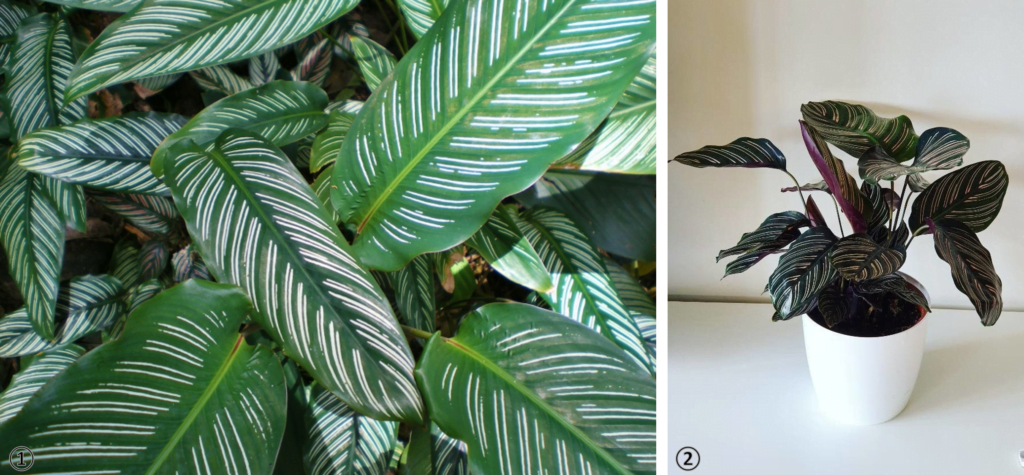
② Potted pinstripe calathea with striking pink stripes. © Ester sa (cc-by-sa) – May 6, 2021 / Pl@ntNet
- Description: Recognized by its striking silver to pink stripes on dark green leaves, this plant is a true beauty. The elongated, lance-shaped foliage features contrasting patterns, resembling delicate brushstrokes.
- Pros: Flourishes in low light conditions, making it an excellent choice for interior spaces with limited sunlight. Its elegant appearance adds a touch of sophistication to any room.
- Cons: Exhibits sensitivity to overwatering, so a well-draining soil mix is crucial. Additionally, it thrives in high humidity, requiring occasional misting or placement near a humidifier.
Calathea veitchiana ‘Medallion‘
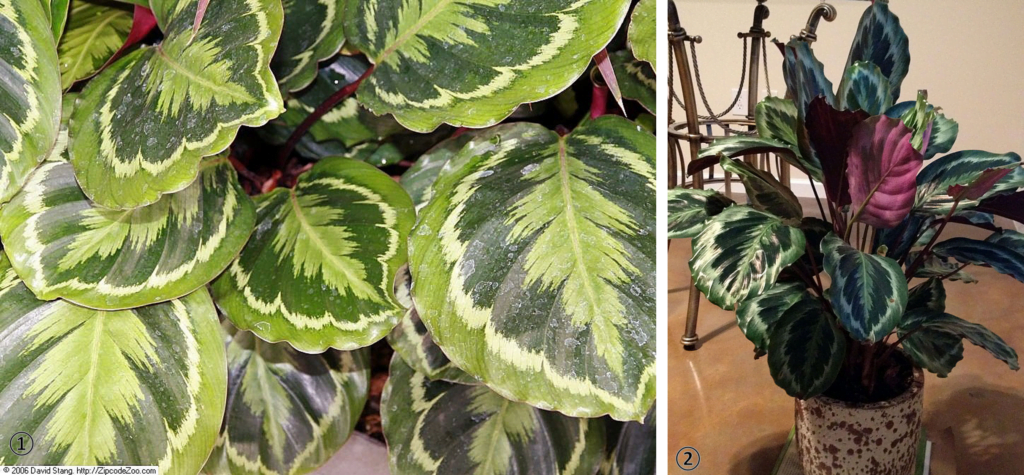
② The ‘Prayer Plant” is commonly grown indoors. © John Thagard, CC BY-SA 3.0, via Wikimedia Commons
- Description: This plant boasts circular leaves with an intricate, medallion-like pattern in shades of green. The foliage is characterized by its unique design, resembling a living piece of art.
- Pros: Adapts well to medium indirect light, making it versatile for various indoor environments. Its captivating foliage serves as an eye-catching focal point.
- Cons: Prone to spider mites, especially in drier conditions. Regular misting helps mitigate this risk, and keeping the soil consistently moist is essential.
Calathea zebrina (Zebra Plant)
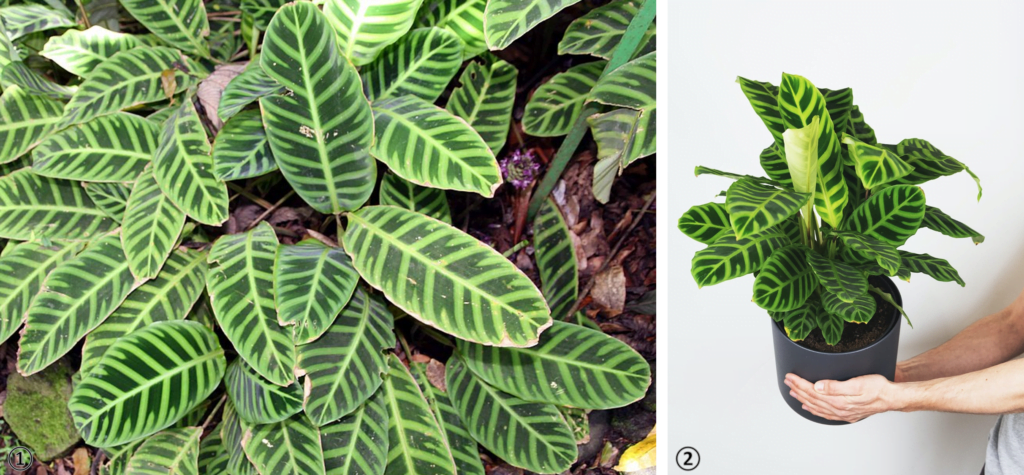
② Studio shot of the exceptional Calathea zebrina. Photo by feey on Unsplash
- Description: This one earned its name from the distinct zebra-like stripes that adorn its elongated, lance-shaped leaves. The contrasting green and deep purple hues contribute to its bold appearance.
- Pros: Flourishes in bright, indirect light, making it a perfect choice for spaces with ample natural light. The unique patterning adds a tropical touch to interiors.
- Cons: Sensitive to temperature changes, zebra plant requires consistent warmth. Protect it from drafts and cold conditions to ensure optimal growth.
Calathea lancifolia (Rattlesnake Plant)
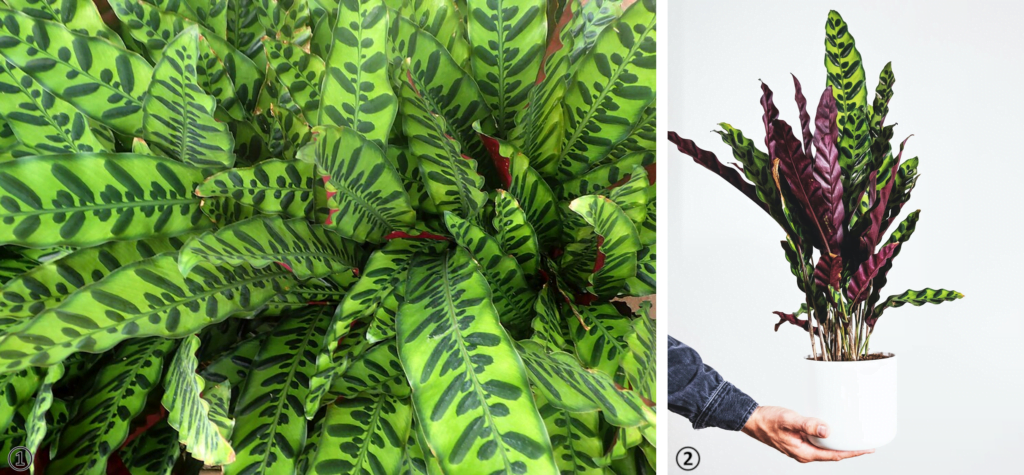
② Studio shot of a hand holding a Calathea lancifolia in a white pot. Photo by feey on Unsplash
- Description: Known for its long, wavy-edged leaves featuring patterns reminiscent of a rattlesnake’s skin, this variety offers a distinctive and captivating aesthetic.
- Pros: Tolerates lower light conditions, making it suitable for areas with reduced natural light. The unique leaf pattern adds visual interest to any space.
- Cons: Susceptible to root rot, this plant thrives in well-draining soil to prevent waterlogging. Regular monitoring of soil moisture is essential.
Calathea orbifolia
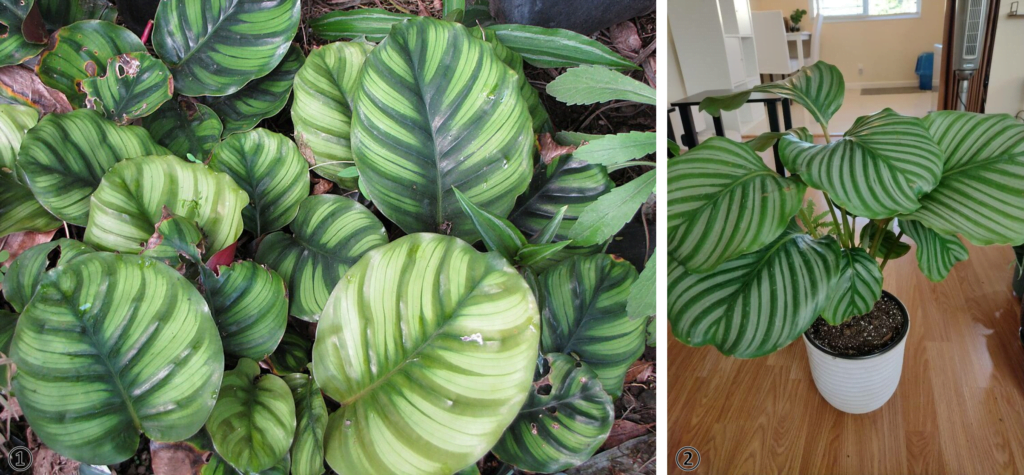
② Potted calathea orbifolia. © SqueakyKitty (cc-by-sa) – Apr 23, 2022 / Pl@ntNet
- Description: This variety showcases round leaves adorned with silver-green stripes, creating a mesmerizing and elegant appearance.
- Pros: Thrives in low to medium light, making it adaptable to various indoor settings. Its calming and sophisticated appearance enhances interior aesthetics.
- Cons: Sensitive to cold drafts, this plant benefits from regular dusting to keep its foliage clean and healthy.
Calathea roseopicta (Rose-Painted Calathea)

② Potted rose-painted calathea by the window. © Michal Svit (cc-by-sa) – Aug 26, 2022 / Pl@ntNet
- Description: Featuring rosy patterns on dark green leaves, this variety adds a painterly touch to indoor spaces.
- Pros: Adaptable to various light conditions, from medium to bright indirect light. Its unique coloration and leaf shape make it a sought-after choice for plant enthusiasts.
- Cons: Prone to leaf browning, requiring consistent moisture and a stable humidity level to prevent drying.
Calathea musaica (Network Calathea)
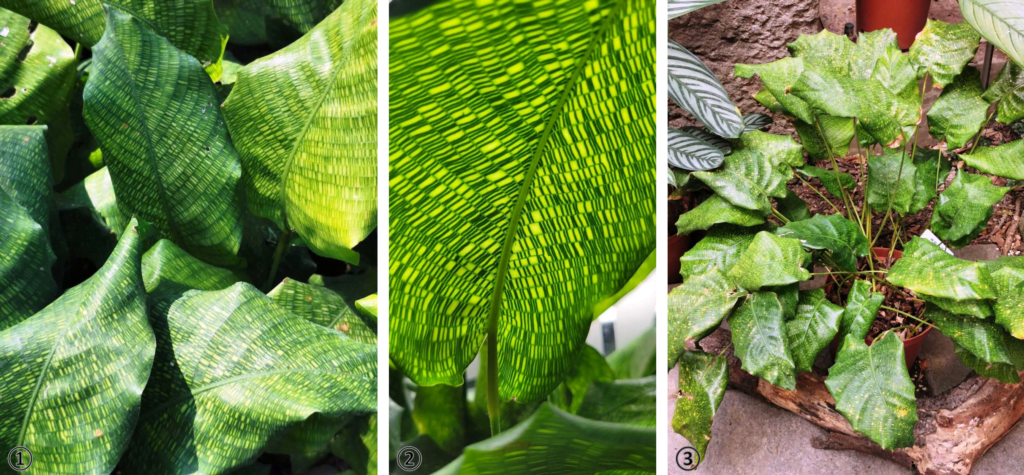
② Close-up to intricate leaf patterns, resembling a network of veins. © Hélène lowinger (cc-by-sa) – Oct 22, 2023 / Pl@ntNet
③ Calathea musaica (W.Bull.) L.H.Bailey. Top view. Botanical Garden of National Museum of Natural Science, Taichung, Taiwan. © Ping an Chang, CC BY-SA 4.0, via Wikimedia Commons
- Description: Calathea musaica stands out with its intricate mosaic-like patterns on elongated leaves, resembling a network of veins.
- Pros: Boasts a unique visual appeal, making it a conversation starter in any indoor setting. Thrives in bright indirect light.
- Cons: Demands high humidity levels, necessitating regular misting or placement in a humid environment. Sensitive to overwatering, requiring a well-balanced watering routine.
Care and Maintenance of Calathea
Cultivating the perfect environment for your Calatheas is crucial to ensure their vibrant foliage remains a testament to their natural beauty. Here’s a comprehensive guide to their care and maintenance:
Light
Calatheas thrive in bright, indirect light. Avoid exposing them to direct sunlight, as it can scorch their delicate leaves. A filtered or dappled light setting mimics their native habitat, making them ideal for spaces with sheer curtains or indoor locations away from direct rays.
Watering
Keep the soil consistently moist but not waterlogged. Allow the top inch of the soil to dry before watering again. Calatheas are sensitive to both overwatering and underwatering, so finding the right balance is key. Use room temperature water to avoid shocking the plant.
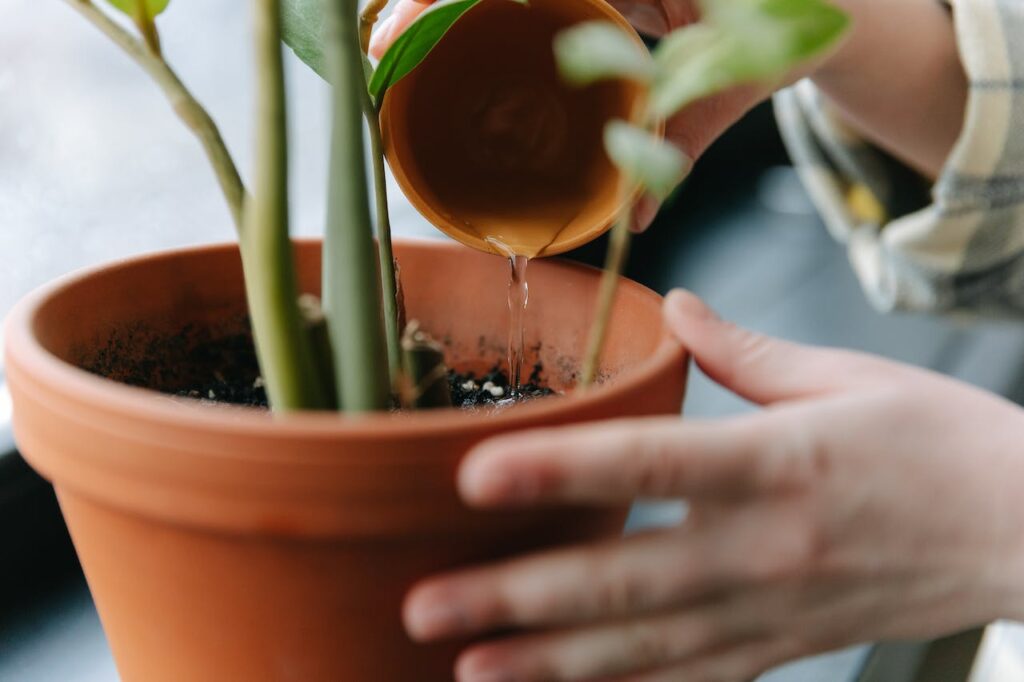
Humidity
Calatheas adore high humidity. Maintain levels above 50% by misting the leaves regularly or placing a humidifier nearby. In drier climates or during winter when indoor heating reduces humidity, consider placing a tray of water near the plant.
Soil
Opt for a well-draining potting mix rich in organic matter. This helps prevent waterlogging, a common woe for these beautiful plants. A mix designed for tropical plants with added perlite or orchid bark works well.
Temperature
Calatheas prefer warmth and detest cold drafts. Maintain temperatures between 65-80°F (18-27°C) to keep them thriving. Protect them from sudden temperature fluctuations, especially during winter.
Pruning and Cleaning
Trim brown or yellowed leaves regularly to encourage new growth. Wipe the leaves with a damp cloth to remove dust, allowing the plant to breathe and absorb light more efficiently.
Propagation of Calathea Plants
Propagating Calatheas allows you to share the beauty of these plants or expand your collection. Follow these steps for successful propagation:
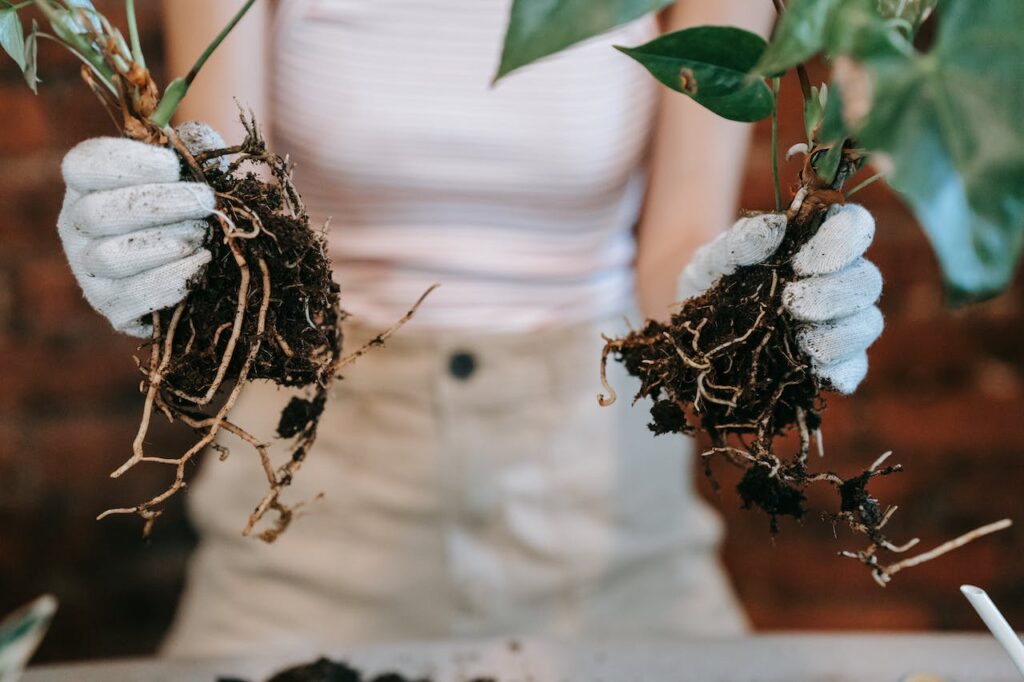
Division
During the plant’s active growth phase, typically in spring or early summer, consider dividing mature sections.
Gently remove the plant from its pot and separate the rhizomes into sections, ensuring each division has roots and healthy foliage.
Soil and Potting
Plant the divisions in fresh, well-draining soil. Choose a pot with adequate drainage to prevent waterlogging.
Maintain a similar environment to the parent plant, including light, humidity, and temperature conditions.
Rooting Hormone (Optional)
If you want to boost the chances of successful propagation, dip the cut sections in a rooting hormone before planting.
While not necessary, it can expedite root development.
Care for New Plants
After planting, provide a nurturing environment. Keep the soil consistently moist but not waterlogged, and shield the new plants from direct sunlight until they establish themselves. Once they show signs of new growth, you can gradually acclimate them to their preferred conditions.
By following these care and propagation guidelines, you’ll not only maintain the health and vibrancy of your existing Calatheas but also have the joy of watching new plants flourish and continue the legacy of these captivating botanical wonders.
Where to Get Calatheas
Explore local nurseries, plant shops, or reputable online retailers specializing in tropical plants.
Ensure they provide healthy, well-cared-for specimens, and consider reviews and recommendations for a trustworthy source.
In conclusion, the allure of this so-called prayer plant extends beyond its aesthetic appeal.
Understanding their diverse types, rich history, and proper care enhances the joy of cultivating these mesmerizing plants, bringing a touch of the tropics into your living space.
Conclusion
As we conclude our exploration into the world of Calatheas, it’s evident that these plants are more than mere decorations; they are living expressions of nature’s artistry.
From their intricate patterns to their historical significance, Calatheas beckon us to connect with the essence of the natural world within our homes.
So, let your living space be transformed by the grace of Calatheas – a celebration of biodiversity, a testament to resilience, and a reminder that in nurturing these plants, we partake in a timeless communion with the beauty of the botanical realm.
May your journey with Calatheas be as enriching and captivating as the plants themselves.
Also Read: What Is A Blue Butterfly Pea Flower: Characteristics, Usage, And Cultivation
Well, what do you think about the article?
Did you enjoy reading “What Is A Calathea Plant: Types, History, And Care Guide“?
We really hope that you have enjoyed this article. If you have any thoughts or comments about this post, please feel free to share them in the comment section below. We appreciate your feedback and would be glad to hear from you.
To see more content like this check the gardening section of Money For My Beer.

Lara is a freelance content writer and a cat mom to three furbabies, Mizu, Haru and Sora.
She graduated with a Bachelor’s Degree in Architecture and is a registered and licensed Architect. Aside from writing, she is fond of growing cacti and succulents and is a DIY type of girl.
During her free time, she engages herself in water-colouring and crocheting, while catching-up with an old tv series she just discovered. Lara loves to explore new places, but most of the time stays in her hometown province, reading historical romance novels over a cup of coffee – or matcha.

